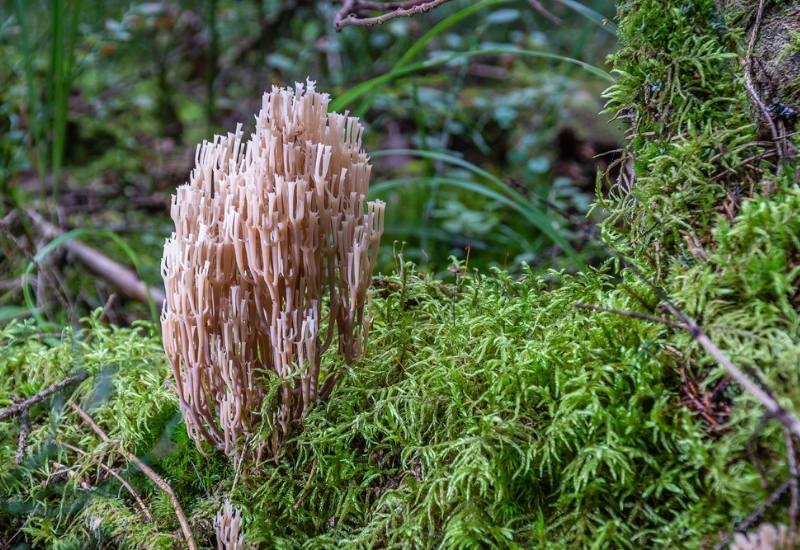
Both sphagnum moss and peat moss are common non soil based potting mix components in gardening. They have many common traits, and in fact did you know that they are the same plant?
But using them requires some technical knowledge about their similarities, but also differences. So, before you buy one, let me tell you more…
Both peat moss or sphagnum peat moss and sphagnum moss come from bryophite plants of the Sphagnopisda class, which grow on peat fields.
But they are harvested at different phases of the plants’ life cycles and have differences, especially:
For this reason, they have similar but also slightly different uses in gardening. Read this article and you will find out everything about peat and sphagnum moss: how they form, their qualities and properties and, of course, what they are good for in gardening.
Is Sphagnum Moss The Same As Peat Moss?
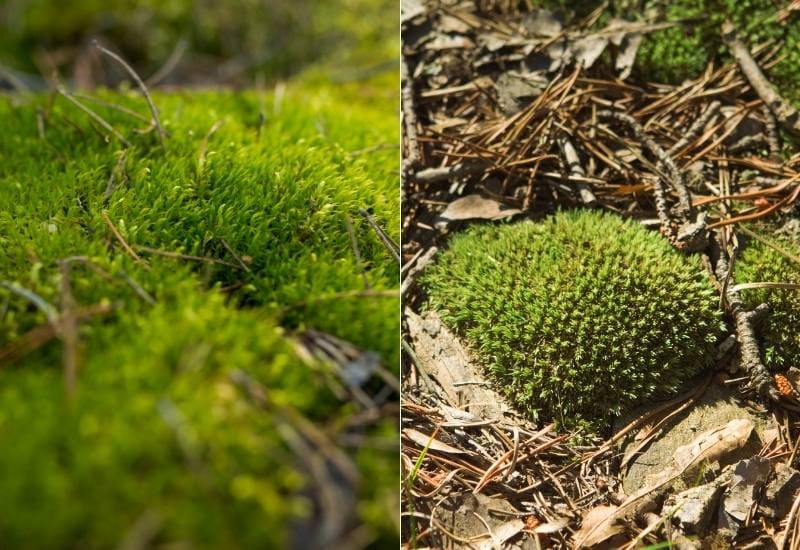
Both peat moss and sphagnum moss come from the same group of plants. These are often called brypohites, which is actually an informal division of plants. These reproduce via spores rather than flowers.
Sphagnum and peat moss plants are, of course mosses, and they belong to the Sphagnopsida class, or a large botanical group of 380 different species of moss.
So, when we talk about peat moss or sphagnum moss, we actually mean an awful lot of different plants.
But these moss plants all have a few things in common: they grow on peat fields. This is very important for us, because it is the reason why we use them in gardening.
Peat Fields: The “Home” of Sphagnum and Peat Moss
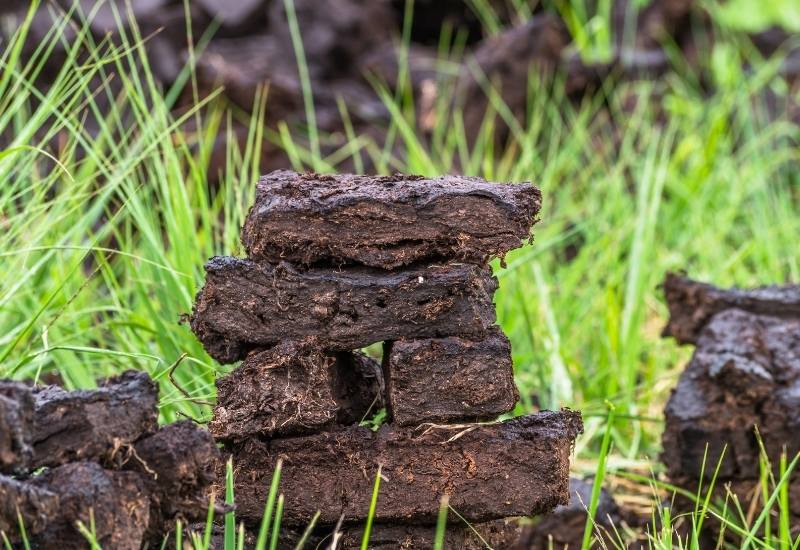
A peat field has very particular qualities. When you think about a field, in fact, you imagine soil and you imagine that when it rains, the water filters into the soil, right? Well, it’s not like this for peat fields!
In fact, a peat filed is impermeable. This means that rainwater does not get into the soil. Instead it stays on top.
Sphagnsida like to grow on the water on top of the peat moss. They are not soil plants, but bog plants. In fact, peat fields are also called peat bogs or peatlands.
Peat bogs (or fields) are common in many temperate, cold and continental areas, and in some tropical areas too.
Countries that have lots of peatlands are the USA, Canada, Russia, Mongolia, Norway, Iceland, Ireland, Borneo and Papua New Guinea.
The USA has 51 million acres of peat fields, distributed over 42 countries. On the whole, there are 400 million hectares of peatland in the world, or 3% of the whole surface of land on the planet. But how do peat moss and sphagnum moss generate on peat bogs?
Peat Moss and Sphagnum Moss: The Same Plants at Different Stages
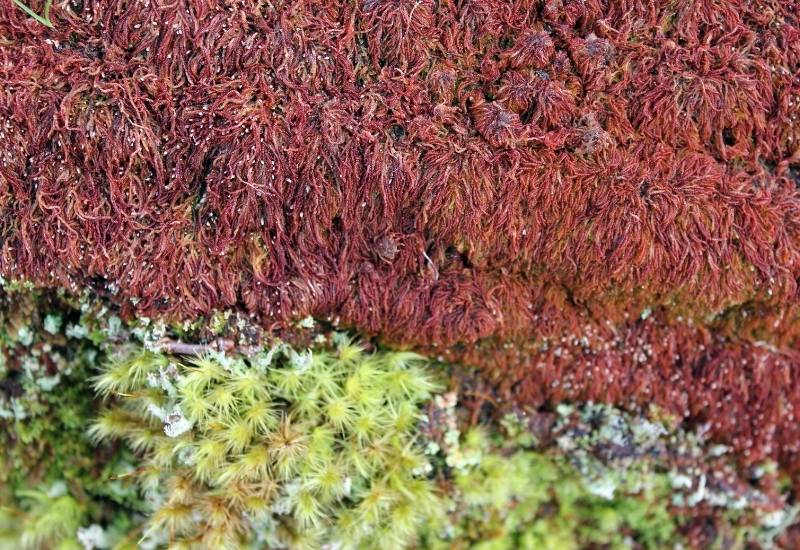
Sphagnum moss is quite simple to understand. Sphagnum moss is simply moss harvested from peat fields and then dried up.
It is taken from the surface of peat fields. It is collected when it is still alive. However, when you buy it, it is dry and therefore dead.
On the other hand, peat moss is already dead when you harvest it. When the plants dies, in fact, they fall under the water surface.
This starts a very special process. The reason is that the water in the surface of the bog stops the air from getting into the soil below.
To decompose, leaves, fibers etc. need air. The same as happens with fossils, isn’t it? If an animal and the body ends up in a place without air, it preserves well.
This is what happens with peat moss. It changes, in color, in consistency etc., but it does not decompose.
So peat moss is harvested from under the surface of peat bogs, and it is made up of dead, compacted but not decomposed plants.
You see how both come from the same place, both come from the same plants, but they come from different stages of the plants’ cycles.
And I can hear your question, very good one indeed… Are peat moss and sphagnum moss eco-friendly and renewable?
Peat Moss and Sphagnum Moss: The Environmental Question
All gardeners are environmentally aware, and both peat moss and sphagnum moss pose serious questions: are they renewable?
Some people have insisted, especially in the past, in saying that they are renewable. And they have a point. Peat fields form new sphagnum and peat moss all the time.
The problem is that the rate with which they renew does not keep up with our harvesting rate.
So the answer is that they are renewable but they cannot renew fast enough to be sustainable.
This is the reason why we will close this article with some substitutes for peat and sphagnum moss.
Which Is Less Bad for the Environment – Peat Moss or Sphagnum Moss?
Both peat moss and sphagnum moss are bad for the environment. However, the difference comes from the way they are harvested.
Remember that one is alive and from the surface (Sphagnum), the other is dead and from underneath.
To collect peat moss you disturb the peat fields much more than to harvest sphagnum moss: you need to dig deeper, to start with.
Next, you also collect material which has taken many years to form, a bit like with coal, while sphagnum moss is produced (therefore replenished) faster than peat moss.
For these two reasons we can safely say that both peat moss and sphagnum moss have negative environmental impacts, but peat moss is much worse.
Having said this, which is very important, you may want to know how you can use these two materials in gardening? Just read on…
General Use of Peat Moss and Sphagnum Moss
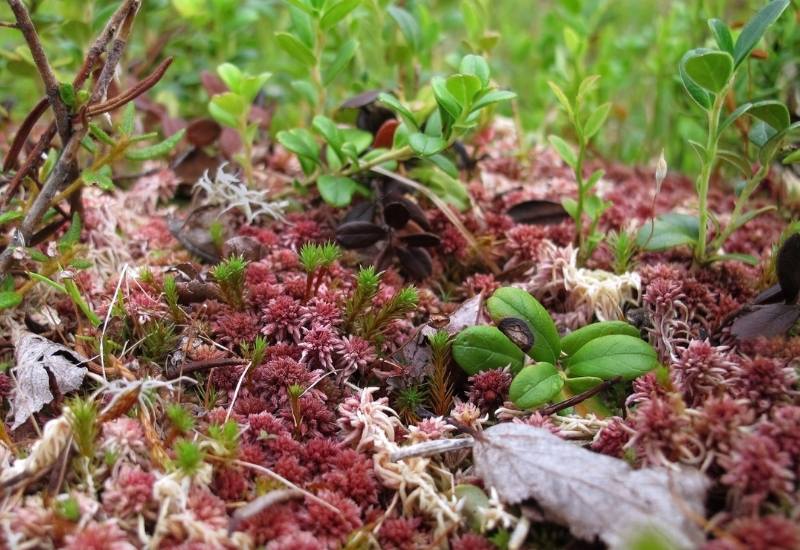
Both peat moss and sphagnum moss are used in gardening, but not only. However, when it comes to our hobby (or profession) their main uses are:
Now you know how you can use them, let me tell you how you can recognize them.
How to Tell Sphagnum Moss and Peat Moss Apart
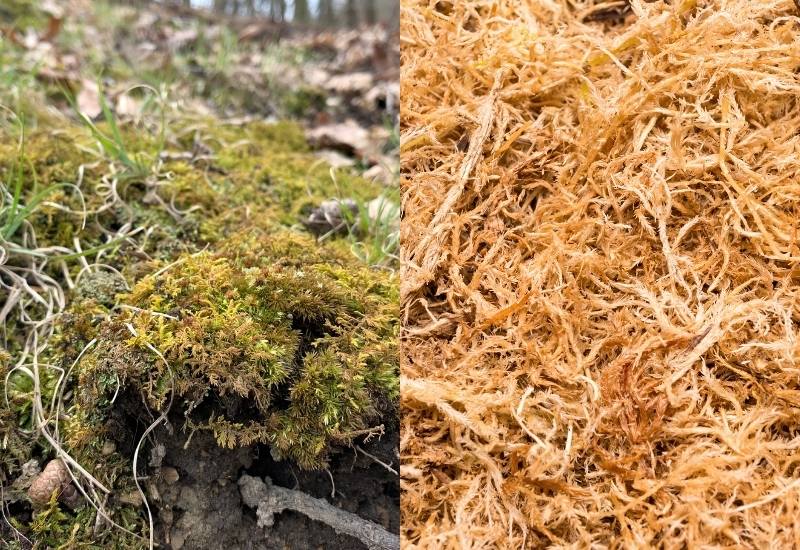
What do sphagnum moss and peat moss look like? Even in this respect, they are similar but different.
In fact both look like “organic fibers, in both cases, you can tell that you are dealing with small dead plants.
However, sphagnum moss is far more intact than peat moss. In sphagnum moss, you can literally see the little dried plants of moss.
This also gives sphagnum moss a more loose appearance than peat moss. It is lighter, less compact.
On the contrary, peat moss, being more compact, usually looks darker. On the whole, you would be forgiven for confusing peat moss with compost.
Their look is not that dissimilar. However, looking closely, with peat moss you can still see that it is made up of small little dry plants.
This does not happen with compost (which is made up of decomposed organic matte from many different plant parts and not only). Now you know what they look like, let’s see “what they do”.
Water Retention in Sphagnum Moss and Peat Moss
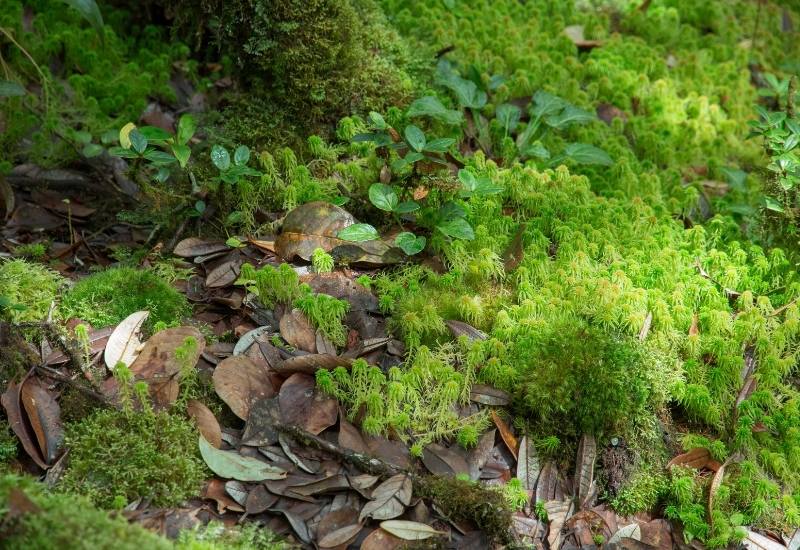
Water retention is how much water a growing medium or soil can hold, in our case peat moss or sphagnum moss. It is of course a very important factor to consider.
In fact, you can use both peat moss and sphagnum moss to improve your soil’s water retention.
This is good to improve “hard soil” like clay or chalk.
But this is also very useful to improve water retention in sandy soil. In fact, sandy soil is perfect for aeration, for drainage and to lighten or break up chalk and clay.
But it does not hold on well to water. Organic matter in general holds on well to water, but why are peat and sphagnum moss excellent?
The Secret of Fibers and Water
Sphagnum moss and peat moss are fibrous matter. Fibers have some excellent qualities when it comes to water retention and release.
The fact us that vegetable fibers, once dried up, can be “re-hydrated” with water. Basically, all the moisture that has been lost can be added to them again.
But there is more: vegetable fibers release water slowly, at different rates. You see, the fact is that the pockets that fill with water inside the fibers are all of different sizes.
This means that some empty faster, and others more slowly, allowing a slow and constant release of water to the soil or / and roots.
Water Retention: Which Is Better, Sphagnum Moss or Peat Moss?
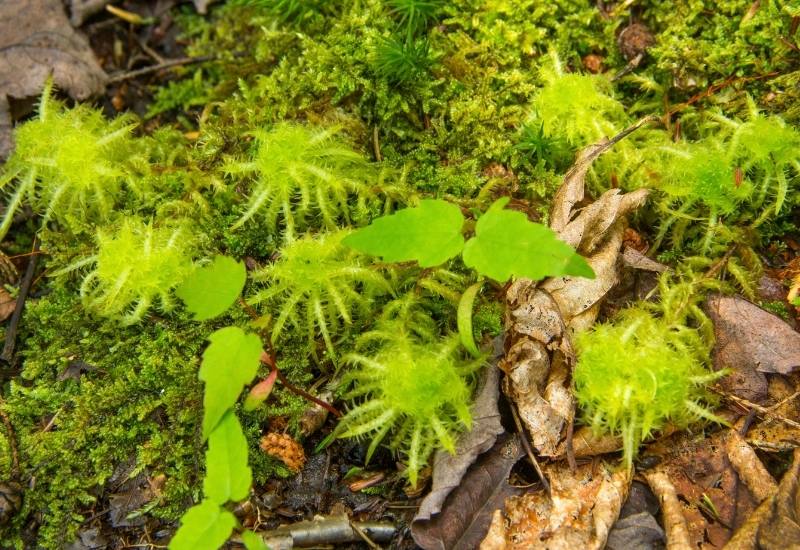
But what is the difference between the water retention of sphagnum moss and that if peat moss? In terms of water retention, sphagnum moss and peat moss are comparable.
In fact, peat moss can absorb up to 20 times its weight in water. That’s a lot! But how about its competitor?
Sphagnum moss can absorb between 16 an 26 times its weight in water. As you can see, there is no huge difference,
but if we want to be precise, sphagnum moss is slightly better than peat moss at retaining water. And water release in sphagnum and peat moss is virtually the same.
What’s Better for Your Hydroponic Garden: Sphagnum Moss or Peat Moss?
Talking about water, the question of which is better for hydroponics, sphagnum or peat moss, is very important.
In hydroponics, one of the key functions of the growing medium you choose is to release the nutrient solution (water and nutrients) to the roots.
Even if the water release rate of both growing media is the same, sphagnum moss is slightly better for hydroponics than peat moss.
The issue with peat moss is mechanical. You see, peat moss tends to form clumps around the roots of plants in some hydroponic systems.
It basically commemorates around the roots, forming “root balls”. These, in turn, suffocate the roots, depriving them of oxygen.
You can still use peat moss as a hydroponic medium, but you need to mix it with perlite or something similar. This leads us to another point: nutrients.
Feed Your Plants with Peat Moss and Sphagnum Moss
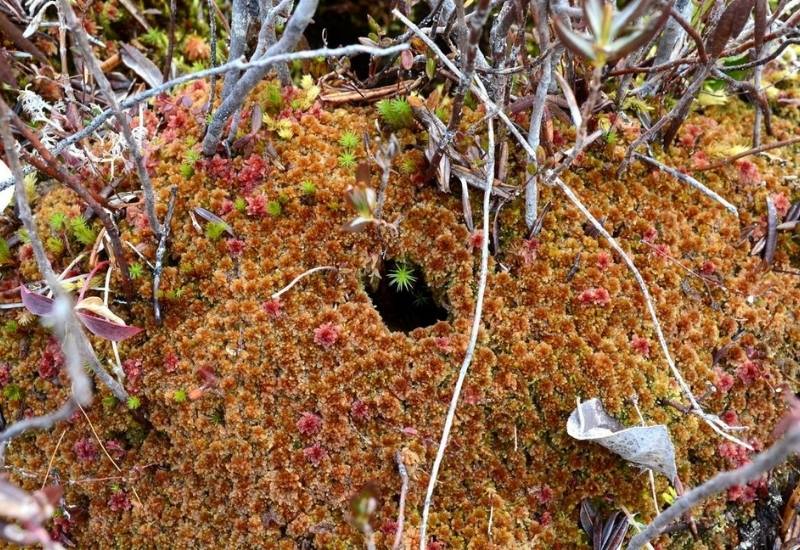
Ok, unlike compost, peat moss and sphagnum moss do not actually feed your plants directly. However, in the same way as they hold on to water, they also hold on to nutrients.
In fact, nutrients dissolve in water, and not just in hydroponics, but in soil gardening too. Some types of soil, like chalk and sand based soils, have poor nutrient retention properties.
So, you can use peat moss and sphagnum moss to improve your soil’s ability to hold on to nutrients and release them slowly.
Keep Your Plants Warm with Sphagnum Moss
Sphagnum moss is also useful to keep the roots of your plants warm! It’s like a little jumper for your plants.
Even peat moss can have this property in a limited way, but sphagnum moss is actually excellent! The fact is that it’s a bit like adding straw or hay to the soil.
Dried up fibers hold on to heat and release it very slowly. This means that if the nights are cold, the roots of your plants will mot feel it as much.
For this reason, sphagnum moss is particularly useful for hanging baskets. Hanging baskets have no shelter from the cold, they receive it from all sides and they are far from heat sources (like the soil).
Many gardeners use sphagnum moss to avoid bug drops in temperature inside these baskets and save plants from stress.
The pH of Peat Moss and Sphagnum Moss
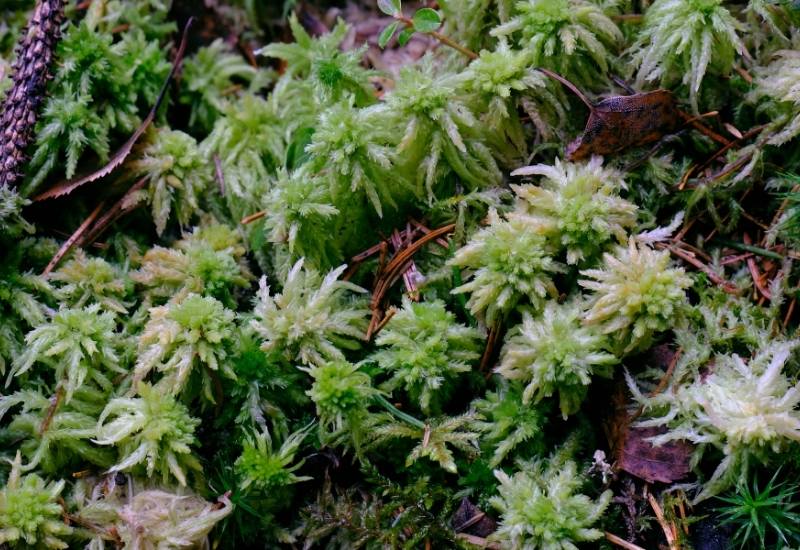
There is a huge difference when it comes to the pH of sphagnum moss and peat moss. The pH scale goes from 1 to 14. 1 is super acidic, and 14 is very alkaline.
Plants have their favorite pH levels. Some like acidic soil (azaleas, camellias, rhododendrons etc.) others like it on the alkaline side (most vegetables like the pH slightly alkaline).
Many plants like or are fine with neutral pH. We say that the pH is neutral when it is neither acidic nor alkaline, or, on the pH scale, around 7.0. So, what is the pH of sphagnum moss and peat moss?
Sphagnum moss has a pH of about 7.0, so it is neutral.
On the other hand, peat moss has a very acidic pH, around 4.0.
Few plants can tolerate a pH under 4.0. So, peat moss makes the soil quite acid.
Using Sphagnum Moss to Correct the Soil’s pH
If you mix sphagnum moss into the soil, it will tend to turn it towards the neutral point. So, sphagnum moss is good to “balance the soil pH” or better make is close to neutral as possible.
In practice, if you add it to acidic soil, it makes it less acidic. If you add it to alkaline soil, it makes it less alkaline.
Using Peat Moss to Correct the Soil’s pH
Unlike sphagnum moss, peat moss will always make the soil more acidic. This means that you can use it as a soil corrector, but only to:
If you want to grow acidophiles, i.e. plants that like acidic soil, and your soil is neutral or not acidic enough, then it will make it more acidic.
Some very popular garden plants are acidophiles, and often the problem with these is that the soil is not acidic enough.
Examples of acidophilic plants include azaleas, rhododendrons, holly, gardenias, heather, blueberries.
If you have these plants in your garden and you see they have yellow leaves, they have problems blooming and their growth is slow, it means that they need acidity in the soil and peat moss corrects it very fast.
But if you add peat moss to alkaline soil, it will reduce its alkalinity and make it more neutral. Chalk is very alkaline, and a very tough type of soil to cultivate.
Few plants actually like it, and peat moss can correct both its alkalinity and its water retention and aeration properties.
On the contrary, if you have used peat moss and you realize that the soil is too acidic now, add lime (chalk) to increase its pH.
Use Peat Moss or Sphagnum Moss for Aeration too!
Both peat moss and sphagnum moss have good aerating qualities. In this respect, they are virtually the same. It all goes back to the fact that they are fibrous matter.
Fibers have holes and pockets of all sizes and these hold on to water, true, but also to air. In fact, so e are actually so tiny that they are perfect for air and harder for water to fill.
What is more, both peat moss and sphagnum moss correct the texture of heavy soil. One of the reasons why air does not get into heavy clay or chalk is that these types of soil are very compact. They have very fine grains that stick together, forming airtight and watertight blocks.
In order to allow air into these types of soil, you need to add materials that break up these blocks. And fibers (or sand) are really excellent at this.
They do not have the same shape, texture, size etc. as the soil, so, instead of forming large “blocks”, these types of soil will form smaller pebbles, and the air will get through.In terms of aeration, sphagnum moss and peat moss are comparable.
Peat Moss Outside Your Garden (and in Your Medicine Cabinet)!
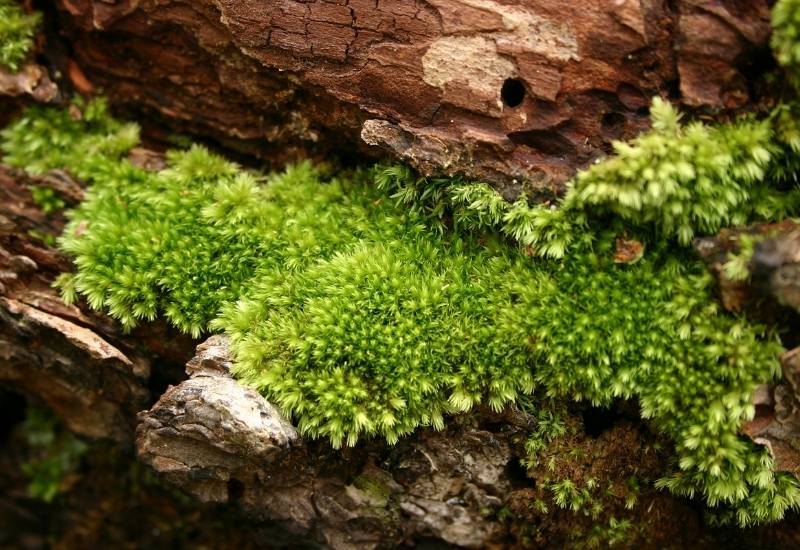
Ok, now you have seen how to use peat moss and sphagnum moss we can have a fee fun facts about these amazing materials…
Let’s start with a lesser known fact… People have been harvesting peat moss in North America for centuries! Yes, Native Americans in fact collected it. As you will expect, they did it sustainably, unlike us.
But it is also true that they did not use it for gardening… No! In fact, they used it as a medicine. Yes, because is good to treat cuts and wounds. To be honest, this use of peat moss is now very marginal..,
Packing with Sphagnum Moss
If we use peat moss almost only for gardening now, we can’t say the same about sphagnum moss… In fact, it has another major market: packaging. It is a bit like straw, in fact, just less messy and more pliable.
For this reason, you will find sphagnum moss in crates and boxes from all over the world, keeping ceramic and glass safe during the journey.
Succulent plants are often delivered with sphagnum moss as padding too. In case, make sure you recycle it and don’t throw it away! Now you know what to do with it…
Beyond Peat Moss and Sphagnum Moss

As you can see, peat moss and sphagnum moss are very useful – but they are not environmentally friendly. Studies even show that peat and sphagnum moss harvesting is contributing to global warming!
So, if you want to have similar results but with a truly recyclable, truly sustainable material, do what many environmentally aware gardeners are doing nowadays: use coconut coir as a replacement.
Coconut coir has very similar properties to sphagnum moss, but it is a by-product of coconut farming. It is fully replaced quickly and in any case, it would just go to waste…

Written By
Adriano Bulla
After many years as an academic in London, Adriano Bulla became a writer, publishing books like A History of Gardening, Organic Gardening and Elements of Garden Design; he then decided to become a gardener, following his childhood dream, and has been following his dream writing and gardening professionally in Southern Europe, where he has specialized in new and innovative organic gardening fields and techniques, like permaculture, regenerative agriculture, food forests and hydroponics.

Thank you for researching useful topic.
Very informative. Very helpful.